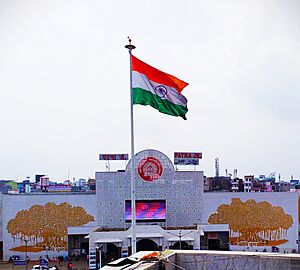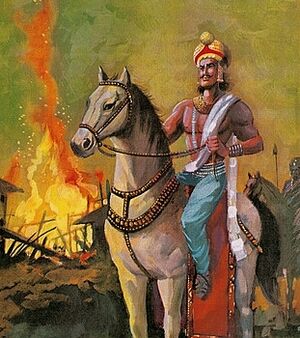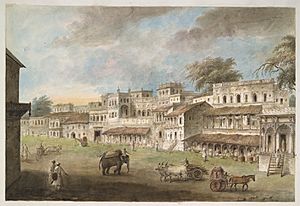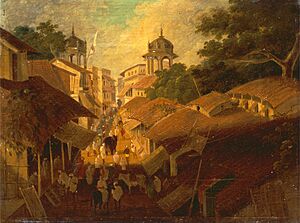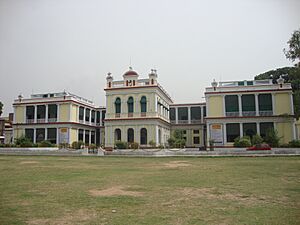History of Patna facts for kids
Patna, the capital of Bihar state in India, is one of the oldest places in the world where people have lived continuously. Its history goes back at least 3,000 years! Patna is special because it's linked to two of the world's oldest religions: Buddhism and Jainism. The ancient city of Pataliputra, which was the old name for modern Patna, was the capital of powerful empires like the Mauryan, Shunga, and Gupta Empires.
Patna has also been part of the Delhi Sultanate and the Mughal Empire. It saw rule by the Nawabs of Bengal, the East India Company, and the British Raj. During British rule, Patna University and many other schools were started. Patna was a key place during the First War of Independence and played a big part in India's fight for freedom. After India became independent, Patna grew to be the biggest city in East India after Kolkata.
Contents
How Patna Began
The first mentions of Patna appear over 2,500 years ago in Jain and Buddhist scriptures. The city's recorded history starts in 490 BCE. At that time, Ajatashatru, the king of Magadha, wanted to move his capital from hilly Rajgriha. He needed a better spot to fight the Licchavi people of Vaishali. He chose a place by the Ganges River and built a fort there. This area then grew into Patna.

Since then, Patna has had a continuous history, which is a rare thing for cities around the world. Over more than 2,000 years, Patna has been known by many names. Some of these include Pataligram, Pataliputra, Palibothra, Kusumpur, Pushpapura, and Azimabad. Gautam Buddha visited this place in the last year of his life. He predicted a great future for it, but also warned it might be ruined by floods, fire, and fights.
What Patna's Name Means
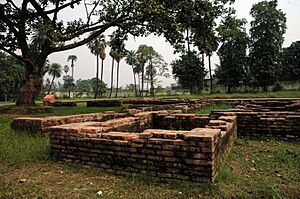
The name Patna comes from the word Pattan, which means "port" in Sanskrit. This makes sense because the city is located where four rivers meet, making it a good port. Another belief is that the city got its name from Patan Devi. She is the main goddess of the city, and her temple is one of the important shakti peethas (places of worship).
Some people also believe the city's name comes from a mythical king named Putraka. He supposedly created Patna with magic for his queen, Patali, which means "trumpet flower." This is why the city was once called Pataligram. It is said that to honor the queen's first child, the city was named Pataliputra. Gram means "village" in Sanskrit, and Putra means "son."
The Haryanka Dynasty
The Haryanka dynasty was founded in 684 BCE. Its first capital was Rajagriha, which later became Pataliputra (modern Patna). This dynasty ruled until 424 BCE, when the Nanda dynasty took over. During this time, two of India's major religions, Buddhism and Jainism, began in Magadha.
King Bimbisara (543-493 BCE) expanded his kingdom by forming alliances through marriage and by conquering lands. The land of Kosala became part of Magadha this way. Bimbisara was later imprisoned and killed by his son, Ajatashatru (491-461 BCE). Ajatashatru became the next ruler and made the dynasty even larger. He fought the Licchavi people many times. Ajatashatru moved the capital of the Magadha kingdom from Rajagriha to Pataliputra. His son, Udayabhadra, later became king. Under his rule, Pataliputra grew to be the largest city in the world.
The Nanda Dynasty
The Nanda dynasty was started by Mahapadma Nanda. He was the illegitimate son of King Mahanandin from the previous Shishunaga dynasty. Mahapadma Nanda was incredibly wealthy and known by titles like "Ekarat" (sole ruler) and "Sarvakshatrantak" (destroyer of all Kshatriyas). During his rule, Alexander the Great invaded India. However, Alexander's soldiers did not want to face the large Magadhan army, which included many elephants, foot soldiers, cavalry, and chariots. So, they left without a battle.
Mahapadma Nanda ruled for most of the dynasty's 100 years and died at age 88. The next ruler, Dhanananda, was not liked by his people and was described as cruel. The Nanda dynasty was followed by the powerful Maurya dynasty.
The Mauryan Empire
With the rise of the Mauryan empire (321 BCE - 185 BCE), Patna, then called Pataliputra, became the center of power for the Indian subcontinent. From Pataliputra, the famous emperor Chandragupta ruled a huge empire. It stretched from the Bay of Bengal all the way to Afghanistan. Chandragupta created a strong government with a complex system, guided by his teacher Kautilya.
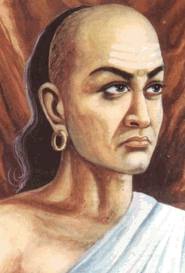
Early Mauryan Pataliputra was mostly built with wood. The wooden buildings and palaces were several stories high and surrounded by parks and ponds. The city also had a special drainage system. Water from every street flowed into a moat, which served as both a defense and a way to get rid of sewage. According to Megasthenes, Pataliputra during Chandragupta's time was "surrounded by a wooden wall with 64 gates and 570 towers." He said it was even more splendid than famous Persian cities like Susa and Ecbatana.
Chandragupta's son, Bindusara, expanded the empire further into central and southern India. Under Ashoka, Chandragupta's grandson, Patna became the effective capital of the entire Indian subcontinent.
Emperor Ashoka changed the wooden capital into a stone city around 273 BCE. The Chinese scholar Fa Hein, who visited India around 399-414 CE, wrote a detailed description of these stone buildings in his travel diary.
Learning and education were greatly supported by the state. Pataliputra was home to several brilliant scholars:
- Aryabhata: A famous astronomer and mathematician who calculated the value of Pi very accurately.
- Ashvaghosha: A poet and important Buddhist writer.
- Chanakya (or Kautilya): A master of statecraft, known as the teacher of Chandragupta Maurya. He wrote the ancient book on how to run a state, Arthashashtra.
- Pāṇini: An ancient Hindu grammarian who created 3,959 rules for Sanskrit grammar.
It is believed that Pataliputra was the largest city in the world between 300 and 195 BCE. It took this title from Alexandria, Egypt, and was later surpassed by the Chinese capital Chang'an (modern Xi'an).
The Gupta Empire
India Before the Guptas
After the last Mauryan king was killed in 184 BCE, India became a collection of separate kingdoms again. Most of the main Magadha areas remained under the Shunga Empire. This empire fought with the Indo-Greeks to protect India's borders. During this time, the most powerful kingdoms were in the south, not the north. However, the north remained culturally active, with Buddhism spreading and Hinduism changing through new ideas. The idea of a single, large empire had not disappeared. It would be brought back by a northern kingdom, leading to a very creative period in Indian history.
The Gupta Dynasty (240-550 CE)
Under Chandragupta I (320-335 CE), the empire in the north was reborn. Like Chandragupta Maurya, he first conquered Magadha. He set up his capital where the Mauryan capital had been (Patna). From this base, he united a kingdom over the eastern part of northern India. Chandragupta I also brought back many of Ashoka's ideas for government. However, it was his son, Samudragupta (335-376 CE), and later his grandson, Chandragupta II (376-415 CE), who expanded the kingdom into an empire across all of northern India and the western Deccan. Chandragupta II was the greatest of the Gupta kings. He was called Vikramaditya ("The Sun of Power") and led the greatest cultural age in Classical India.
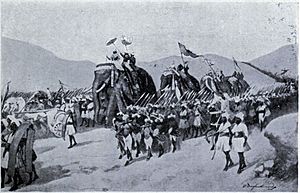
This time is seen as the golden age of Indian culture. It produced amazing and creative architecture, sculptures, and paintings. The wall paintings in the Ajanta Caves in the central Deccan are considered some of the greatest Indian artworks. These paintings show different lives of the Buddha and also give us the best look at daily life in India at that time. There are 48 caves at Ajanta, most carved between 460 and 480 CE, filled with Buddhist sculptures. The rock temple at Elephanta (near Mumbai) has a powerful, 18-foot statue of the three-headed Shiva, a main Hindu god. Each head shows one of Shiva's roles: creating, preserving, and destroying. This period also saw many Hindu temples being built. All these temples had a hall and a tower.
The greatest writer of this time was Kalidasa. Poetry in the Gupta age included religious poems, lyric poems, and narrative histories. Kalidasa was excellent at lyric poetry, but he is best known for his plays. We have three of his plays, all filled with heroic deeds and comedy. The plays involve misunderstandings and conflict but always end with unity and peace.
The Guptas often allowed local kings to remain in charge as vassal kings. Unlike the Mauryas, they did not combine every kingdom into one single administrative unit. This approach would later be used by the Mughal rulers and the British.
The Guptas soon faced invasions by the Huns, a group of people who originally lived north of China. The Huns' migrations reached as far as Rome. Starting in the 400s, the Huns began to pressure the Guptas. They were first defeated by Skandagupta. However, by 480 CE, they had conquered large parts of Northwestern India. Western India was taken over by 500 CE, and the last Gupta king, ruling a much smaller kingdom, died in 550 CE. However, the Huns were later defeated by Yasovarman and Baladitya, a descendant of the Guptas. The Huns in India, like in Europe, slowly blended into the local population, and their power weakened.
Harsha, who came after the Guptas, quickly worked to rebuild an Indian empire. From 606 to 647 CE, he ruled an empire in northern India. Harsha was one of India's greatest conquerors and also a brilliant administrator. He was a great supporter of culture. His capital city, Kanauj, stretched for miles along the Ganges River and had magnificent buildings. Only a quarter of the taxes he collected went to running the government. The rest went to charity, rewards, and especially to culture: art, literature, music, and religion.
Because of extensive trade, Indian culture became very important around the Bay of Bengal. It deeply influenced the cultures of Burma, Cambodia, and Sri Lanka. In many ways, the period during and after the Gupta dynasty was a time of "Greater India," with much cultural activity in India and neighboring countries based on Indian culture. This changed when Muslim conquerors from Afghanistan arrived from the north, and Muslim rule began around 1100 CE.
The Sultanate Period
After the Gupta empire broke apart and foreign armies like the Hunas repeatedly invaded India, Patna went through uncertain times, like most of northern India.
The area later came under the rule of Shri Harshavardhana Samrat. He took control of all of North-West India, defeating the Hunas, and earned the title "Uttarpatheshwar" (Lord of the North). However, his advances south were stopped by the powerful Chalukya ruler Pulakeshin.
During the Kannauj Triangle period, the region came under the control of the powerful Pala Empire. The famous king of Kashmir, Lalitaditya Muktapida, is said to have passed through the region during his conquests.
In the 12th century, the invader Muhammad of Ghor's forces captured many cities, including Ghazni, Multan, Sindh, Lahore, and Delhi. One of his generals, Qutb-ud-din Aybak, declared himself Sultan of Delhi and started the first dynasty of the Delhi Sultanate. By the mid-12th century, Ikhtiar Uddin Muhammad bin Bakhtiar Khilji, another general of Qutb-ud-din Aybak, invaded Bihar and Bengal. Patna then became part of the Delhi Sultanate. He is said to have destroyed many old centers of learning, especially the Nalanda University near Rajgrih, about 120 km from Patna. Patna, which had already lost its importance as India's political center, also lost its reputation as a center for education and culture.
Foreign invaders often used abandoned Buddhist monasteries (vihara) and temples as military camps. They set up their headquarters in the Nalanda region and called it Bihar, a name that comes from the word Vihar. The area that is now the state of Bihar used to have many Buddhist viharas, which were homes for Buddhist monks. The town still exists and is called Bihar or Bihar Sharif (Nalanda District). Later, Sher Shah Suri moved the headquarters from Bihar to Patana (current Patna), and the whole Magadha region became known as Bihar.
The Mughal Period
The Mughal period was a time of regular provincial rule from Delhi. The most notable time during this era was under Sher Shah, or Sher Shah Suri. Sher Shah Suri came from Sasaram, about 160 km southwest of Patna. He helped Patna become important again in the mid-16th century. After one of his expeditions, while standing by the Ganges River, he imagined a fort and a town there. Sher Shah's fort in Patna no longer exists, but the mosque he built in 1545 still stands. It is built in the Afghan architectural style and has many tombs inside.
The oldest mosque in Patna dates back to 1489 and was built by Alauddin Hussani Shah, one of the Bengal rulers. Locals call it the Begu Hajjam's mosque, named after a barber who had it repaired in 1646.
Mughal emperor Akbar came to Patna in 1574 to defeat the Afghan Chief Daud Khan. Akbar's Secretary of State, who wrote the book Ain-i-Akbari, mentioned Patna as a thriving center for paper, stone, and glass industries. He also noted the high quality of many types of rice grown in Patna, which became famous in Europe as Patna rice.
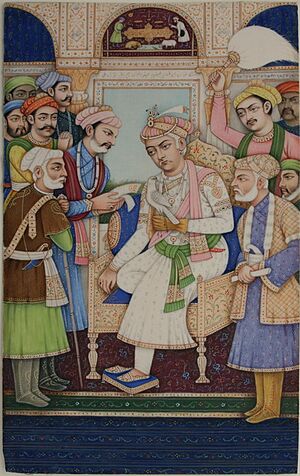
In 1610, during the rule of Jahangir, a lower-class uprising happened in the city. It was led by a man pretending to be Jahangir's son, Khusrau Mirza. The rebels took control of the town for a week before the Mughal army defeated and executed them.
The Jagirdar of Mohrampur ruled over Patna. Patna was the most important city in eastern India after Burdwan and served as the capital of Bihar Subah. In 1704, Mughal Emperor Aurangzeb agreed to his favorite grandson Prince Muhamad Azim's request to rename Patna as Azimabad. This happened while Azim was in Patna as the subedar (governor). However, not much else changed during this period.
The Nawabs of Bengal
As the Mughal empire declined, Patna came under the control of the Nawabs of Bengal. Over time, the city was taken over by local landlords (Jagirdars) who declared themselves Nawabs. The Nawabs of Bengal collected heavy taxes from the people but allowed Patna to thrive as a trading center. During the 17th century, Patna became a hub for international trade.
The British started a factory in Patna in 1620 to buy and store cotton cloth (calico) and silk. Soon, it became a trading center for saltpetre (used in gunpowder). This attracted other European traders—French, Danes, Dutch, and Portuguese—to compete in this profitable business. Many European factories and godowns (warehouses) popped up in Patna. The city gained a reputation for trade that drew merchants from far away. Peter Mundy, writing in 1632, called Patna "the greatest market of the eastern region."
British Colonial Period
Company Rule
After the Battle of Buxar, 1764, both the Mughals and the Nawabs of Bengal lost real control over the province of Bengal. This province included what are now the Indian states of West Bengal, Bihar, Jharkhand, Odisha, and parts of Bangladesh. The East India Company was given the diwani rights. This meant they had the right to collect and manage taxes in Bengal and parts of Oudh (now a large part of Uttar Pradesh). These rights were legally granted by Shah Alam, who was then the ruling sovereign Mughal emperor of Undivided India.
The Battle of Buxar, fought only about 115 km from Patna, marked the beginning of the British East India Company's rule in East India.
During the British East India Company's rule in Bihar, Patna became one of the most important commercial and trading centers in East India, second only to Kolkata.
British Raj
Under the British Raj, Patna slowly regained its former glory. It became an important center for learning and trade in India. When the Bengal Presidency was divided in 1912 to create a separate province, Patna was made the capital of the new Bihar and Orissa. The city expanded westward to include the new administrative area. The township of Bankipore grew along Bailey Road (named after the first Lt. Governor, Charles Stuart Bayley). This area was called the New Capital Area.
Even today, locals call the old part of the city "the City" and the new part "the New Capital Area." The Patna Secretariat with its tall clock tower and the Patna High Court are two impressive buildings from this time of development. J. F. Munnings was the architect who designed these large and grand buildings in colonial Patna.
By 1916–1917, most of the buildings were ready. These buildings show either Indo-Saracenic influence (like Patna Museum and the state Assembly) or clear Renaissance influence (like the Raj Bhawan and the High Court). Some buildings, like the General Post Office (GPO) and the Old Secretariat, have a pseudo-Renaissance style. Some say that the experience gained from building Patna's new capital area was very helpful in building the imperial capital of New Delhi.
The British built several educational institutions in Patna. These included Patna College, Patna Science College, Bihar College of Engineering, Prince of Wales Medical College, and the Patna Veterinary College. With government support, people from Bihar quickly used these opportunities to make these centers famous.
After Orissa became a separate province in 1936, Patna continued as the capital of Bihar province under the British Raj.
Patna played a big part in the Indian independence struggle. The most notable events were the Champaran movement against indigo plantations and the Quit India Movement of 1942.
Post-Independence Era
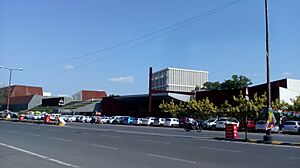
After India gained independence, the Indian National Congress party ruled for many decades. Early Congress leaders like Anugrah Narayan Sinha and Sri Krishna Sinha were freedom fighters. Their popularity among common people helped them gain power quickly. This was before the "Politics of social justice" became important in Bihar's elections in the late 1960s. During the early decades, the upper castes of Bihar held power under the Congress party. They also had a strong presence in local government and administration.
Initially, the Kayastha community, who were very educated, were the first to form their own caste organization. Later, other upper castes like Rajputs and Bhumihars also sought power. They gradually replaced Kayasthas in administration and governance. The politics of Backward castes was not very strong then, and Congress seemed unbeatable.
Growing unhappiness among backward castes with Congress led to the formation of the Triveni Sangh political party. This party was formed by three important backward castes of Bihar. The "Triveni Sangh" aimed to represent backward castes and ensure the rights of lower castes and Dalits. The movement worked to bring lower castes together but failed. This was due to strong competition from Congress's "Backward class federation" and disagreements among the leaders of the three backward castes who formed it. However, outside of elections, it succeeded in ending practices like "Begar" (forced labor). The failure of the Sangh also led to Maoism in rural Bihar. The Ekwaari region, where "Triveni Sangh" began, became a battleground between wealthy upper castes and landless lower castes.
Naxal attacks and the desire of lower castes to improve their social and economic standing, along with opposition from upper castes, led to the formation of caste-based "private armies" in Bihar. Most of these were formed by upper castes, mainly Rajputs and Bhumihars. Some caste armies of new landlords from backward castes like Kurmi and Yadav also existed. Ranvir Sena, Kuer Sena, and Bhumi Sena are some well-known caste armies.
In politics, the power struggle between upper and lower castes ended in 1967. Riding on the slogan of social justice, castes like Koeri, Kurmi, and Yadav replaced the Bhumihars, Rajputs, Brahmins, and Kayasthas. During the time of Karpoori Thakur, quotas in government jobs were promoted. This allowed lower castes to break the upper castes' control in administration and education.
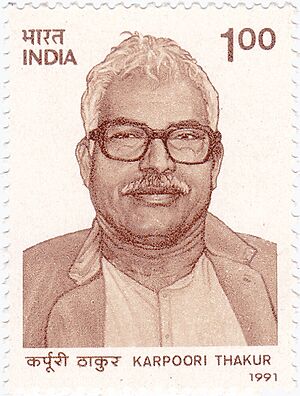
Karpoori Thakur's successors were not as strong. Many Chief Ministers came and went in a short time, but none completed a full five-year term. Only Sri Krishna Sinha had successfully served as Chief Minister for more than five years before this. During this period, caste and community conflicts reached new heights. Leaders like Satyendra Narayan Singh, Bindeshwari Dubey, and Jagannath Mishra all had their own challenges. During Satyendra Narayan Singh's term, the terrible Bhagalpur riots occurred, where over 900 Muslims were killed.
Leaders of this period, like Lalu Prasad and Nitish Kumar, emerged from the "Bihar movement" of 1977. This movement was started by Jay Prakash Narayan. Narayan also launched a social justice movement with Ram Manohar Lohia, which is said to have mainly strengthened the "upper backwards."
Lalu Prasad successfully gave a voice to marginalized groups. However, the upper castes, who felt deliberately sidelined, became his strong critics. A series of violent clashes began in the countryside between upper castes trying to regain power and backward castes striving for power and position. According to Arun Sinha, the three "upper backward" castes were at the forefront of improving their social and political standing. They strongly resisted the upper castes' attempts to dominate again. But growing differences between Yadavs and Kurmi and Koeris led Nitish Kumar to form the Samata Party. The upper castes also supported Nitish to challenge the growing dominance of Yadavs and Lalu Prasad.

Nitish was initially unsuccessful in breaking Lalu Prasad's strong influence on the backward castes. But he successfully came to power after the law and order situation worsened during Rabari Devi's term. This was due to many factors, including the struggle between upper and lower castes. He took strong action to control politicians who had criminal backgrounds, and many powerful figures were jailed, including members of his own party.
As of 2020, the governance of Bihar for the past 15 years has been in the hands of the Janata Dal (United) and Bharatiya Janata Party alliance. Lalu Prasad's Rashtriya Janata Dal is still the largest party in the Bihar Legislative Assembly.
Gallery: Patna as Capital
-
Pataliputra as a capital of the Magadha Empire.
-
Pataliputra as a capital of Maurya Empire.
The Maurya Empire at its largest extent under Ashoka the Great. -
Pataliputra as a capital of Shunga Empire.
Approximate greatest extent of the Shunga Empire (c. 185 BCE). -
Pataliputra as a capital of Sher Shah's Empire.
-
Robert Clive became the first British Governor of Bengal, and Patna (Bihar) was part of Bengal.
-
First Chief Minister of Bihar, Dr. Sri Krishna Sinha.
-
Lalu Prasad Yadav, the longest-serving Chief Minister of Bihar after Srikrishna Sinha.
-
Nitish Kumar, current Chief Minister of Bihar.
See also
- History of Bihar
- Politics of Bihar


